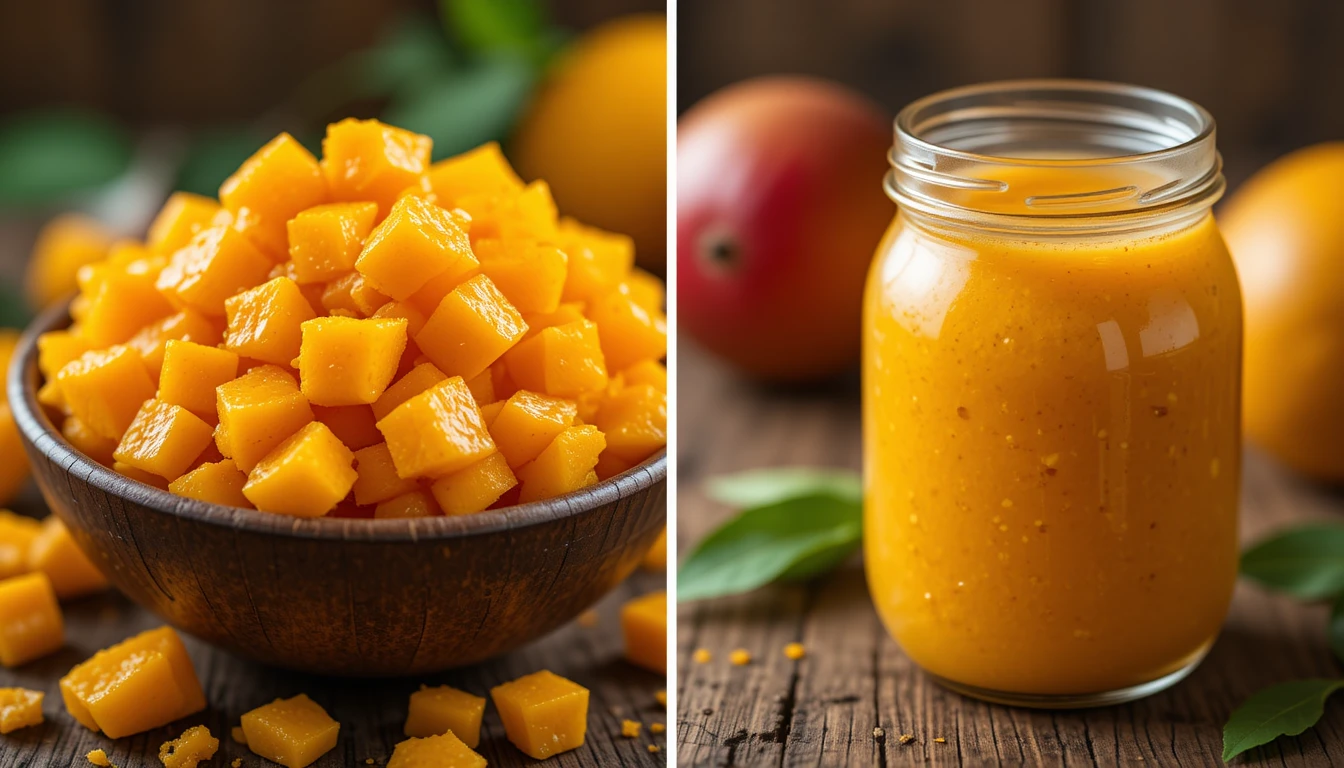Mangoes are loved globally, but the terms mango pulp and mango puree frequently create a buzz. While both involve processing mangoes into a softer form, the differences lie in their texture, preparation, and uses. Understanding these distinctions is crucial to making the right choice for your recipes.
Understanding Mango Pulp and Mango Puree
What is Mango Pulp?
Mango pulp is the extracted, soft, and juicy flesh of the mango fruit. It is typically obtained by peeling and deseeding the mango, followed by scooping or crushing the fruit into a semi-liquid form. This product is minimally processed and retains the natural texture of the fruit, including its fibrous bits.
The pulp is often used as a base ingredient in numerous recipes, especially in traditional dishes, smoothies, and desserts. Since it’s largely unrefined, mango pulp holds the authentic flavor of mangoes, making it a preferred choice for those who love the unaltered taste of the fruit. Additionally, the rich consistency of mango pulp lends itself well to dishes that require a thicker, fruitier texture.
What is Mango Puree?
Mango puree, on the other hand, is a more processed version of mango pulp. It is created by blending the flesh of ripe mangoes until smooth, followed by straining to remove any fibrous particles. This additional step ensures a refined and silkier consistency, making it ideal for dishes that require a polished finish.
Commercial mango puree may include additives such as sweeteners or preservatives, which further distinguish it from its natural counterpart. Its velvety texture and concentrated flavor make mango puree an excellent choice for sauces, beverages, and desserts like mousse or sorbet. With its smoother consistency, mango puree is also widely used in professional culinary settings where presentation is key.
Key Differences Between Mango Pulp and Mango Puree
Texture and Consistency
The primary distinction lies in texture. Mango pulp retains the fruit’s natural fiber, resulting in a slightly coarse consistency. Mango puree, however, is completely smooth and free from fibers, making it ideal for recipes where a refined texture is essential.
Processing Methods
Mango pulp involves minimal processing, which helps maintain the fruit’s natural integrity. It is often scooped out directly from the fruit. Conversely, mango puree undergoes blending and straining to achieve a silky finish, with some commercial versions incorporating additional processing steps for stability.
Culinary Uses
Mango pulp is favored in recipes where the natural, robust flavor and texture of mango are desired, such as traditional mango lassi or mango-based desserts. Mango puree, however, is better suited for culinary creations requiring a smooth and uniform consistency, such as custards, glazes, and cocktails.
The choice between mango pulp and mango puree often depends on the requirements of a specific recipe. Understanding their unique qualities ensures the right product is chosen, resulting in a better culinary experience.
Culinary Applications
Uses of Mango Pulp in Cooking
Mango pulp is a versatile ingredient used across various cuisines. Its naturally thick consistency and bold flavor make it perfect for traditional recipes, such as mango chutney, lassi, or aamras, a popular Indian dish. Because of its natural sweetness and texture, mango pulp also shines in fruit salads, milkshakes, and tropical smoothies.
In baking, mango pulp is often used to flavor cakes, muffins, and puddings. Its fibrous texture works particularly well in rustic desserts where a chunkier consistency enhances the dish’s appeal. Moreover, its vibrant color and tangy undertones make it a fantastic base for sauces or marinades in savory dishes, particularly those involving seafood or chicken.
Uses of Mango Puree in Cooking
Mango puree finds its place in recipes that demand refinement and elegance. Its smooth texture and concentrated mango flavor make it an ideal ingredient in mango mousse, sorbets, and panna cotta. The puree’s consistency ensures it blends seamlessly into desserts like cheesecakes or creams, enhancing both flavor and texture.
Beyond desserts, mango puree is commonly used to create glazes for meats, dressings for salads, or even syrups for cocktails. Its uniformity allows it to be drizzled decoratively, making it a popular choice in professional kitchens. Whether used in smoothies or gourmet dishes, mango puree adds a touch of sophistication to any culinary creation.
Can Mango Pulp and Puree Be Used Interchangeably?
While mango pulp and mango puree share similarities, they aren’t always interchangeable. In recipes where texture isn’t critical, such as smoothies or simple desserts, you can often substitute one for the other without significant issues. However, the fiber content in mango pulp may alter the texture slightly compared to the smoothness of mango puree.
For recipes requiring a silky finish—such as custards, sauces, or syrups—mango puree is the better choice. Substituting mango pulp in such cases might result in a grittier texture, which could compromise the dish’s presentation and mouthfeel.
Another factor to consider is sweetness. Commercial mango puree may contain added sugars, altering the overall taste of your dish if substituted with unsweetened mango pulp. Adjustments to sweetness levels are often necessary in these cases.
In conclusion, while both mango pulp and puree are made from the same fruit, their specific characteristics dictate how and where they are best used in cooking.
Nutritional and Health Aspects
Nutritional Profile of Mango Pulp
Mango pulp, derived from the ripe flesh of mangoes, is not just delicious—it’s packed with essential nutrients. Rich in vitamins, particularly vitamin C, it supports immune health and helps the body combat oxidative stress. Additionally, mango pulp is a good source of vitamin A, which promotes eye health, skin regeneration, and cellular growth.
Loaded with natural sugars and carbohydrates, mango pulp serves as a quick energy booster. It also contains a fair amount of dietary fiber, aiding digestion and promoting gut health. Mango pulp is low in fat, making it an excellent choice for those seeking a nutrient-dense, low-fat ingredient. Trace minerals like potassium, magnesium, and calcium add to its appeal, contributing to heart health and bone strength.
Nutritional Profile of Mango Puree
Mango puree offers a similar nutrient profile to mango pulp, but with slight variations depending on preparation and additives. It retains the essential vitamins A and C, supporting overall health and immunity. The puree is also a source of antioxidants, which fight free radicals and may reduce the risk of chronic diseases.
Unlike mango pulp, commercial mango puree may include added sugars, slightly increasing its caloric value. However, homemade puree preserves the natural sugars and nutrients of the fruit. The silky texture of mango puree makes it a nutrient-rich choice for recipes, offering the same vital minerals, including potassium and magnesium, as pulp.
For individuals seeking a smoother option with concentrated flavor and nutrients, mango puree is an excellent choice, especially in recipes requiring uniformity.
Health Benefits of Consuming Mango Products
Antioxidant Properties
Mango pulp and puree are both rich in polyphenols and beta-carotene, powerful antioxidants that combat oxidative stress in the body. These antioxidants are known to reduce inflammation, support heart health, and potentially lower the risk of certain cancers.
Digestive Health
Mango products are high in dietary fiber, which is essential for maintaining a healthy digestive system. Fiber aids in regular bowel movements and promotes the growth of beneficial gut bacteria. Additionally, enzymes like amylase in mangoes help break down carbohydrates, making digestion smoother.
Boosting Immunity and Skin Health
The high vitamin C content in mango pulp and puree boosts immunity, aiding the body in warding off infections. Moreover, the presence of vitamin A supports skin health, promoting a youthful glow and assisting in repairing skin cells.
Natural Energy Source
The natural sugars found in mango pulp and puree provide a quick and healthy source of energy, making them ideal for pre-workout snacks or refreshing beverages.
Both mango pulp and puree are nutrient-dense and offer numerous health benefits. Whether consumed as part of a meal or a snack, these mango products can enhance overall well-being.
Preparation and Storage
How to Make Mango Pulp at Home
Making mango pulp at home is simple and ensures a fresh, unadulterated product.
- Choose ripe mangoes: Select mangoes that are fully ripe for the best flavor and sweetness. Varieties like Alphonso or Kesar are ideal.
- Wash and peel: Rinse the mangoes thoroughly under running water, then peel the skin using a knife or vegetable peeler.
- Remove the seed: Slice the fruit lengthwise along the seed and scoop out the flesh using a spoon.
- Blend (optional): For a smoother pulp, blend the flesh lightly in a food processor or blender. However, for traditional uses, the pulp can be used as is.
- Store properly: Transfer the pulp into an airtight container and refrigerate it for up to 5 days or freeze it for longer shelf life.
How to Make Mango Puree at Home
Mango puree requires a few extra steps compared to mango pulp, but the result is a smooth, versatile product.
- Prepare the mangoes: Follow the same steps as for mango pulp—selecting, washing, peeling, and deseeding the mangoes.
- Blend thoroughly: Place the mango flesh into a blender and blend until completely smooth. Unlike pulp, there should be no lumps or fibers.
- Strain (optional): For an ultra-smooth texture, strain the puree through a fine-mesh sieve. This step is particularly important for recipes requiring refinement.
- Store in appropriate containers: Store the puree in a jar or airtight container, refrigerating it for up to 5 days. Freeze portions in airtight bags for extended use.
Storage Tips
Proper storage of mango pulp and puree ensures they remain fresh and flavorful.
- Refrigeration: Both mango pulp and puree can be stored in the refrigerator for up to 5 days. Always use an airtight container to prevent moisture loss or contamination.
- Freezing: For long-term storage, freeze mango pulp or puree in freezer-safe bags or containers. Divide them into portions to avoid defrosting large quantities unnecessarily.
- Avoid metallic containers: Use glass or plastic containers to store mango products, as metallic containers may alter the flavor.
- Label and date: Label the storage containers with the preparation date to track freshness.
Following these preparation and storage tips ensures you have fresh, high-quality mango pulp or puree on hand for a variety of uses.
Conclusion
Summarizing the Differences and Uses of Mango Pulp and Puree
Mango pulp and mango puree may originate from the same fruit, but their differences in texture, processing, and applications set them apart. Mango pulp, with its fibrous and slightly coarse consistency, is the more natural form of processed mango. It is ideal for traditional dishes, smoothies, and desserts that celebrate the authentic taste of mango.
Mango puree, on the other hand, offers a refined and silky texture, making it suitable for recipes requiring uniformity and presentation. From gourmet desserts to elegant sauces, mango puree’s versatility makes it a favorite in modern cooking. Its smoother texture also makes it a better fit for beverages, glazes, and professional culinary creations.
Nutritionally, both mango pulp and puree are excellent sources of vitamins, antioxidants, and natural sugars, providing a range of health benefits from boosting immunity to aiding digestion. However, the choice between the two often depends on the recipe’s requirements, whether it calls for the rustic charm of pulp or the polished elegance of puree.
Ultimately, understanding these distinctions ensures you use the right product in your kitchen, enhancing your culinary experiences while enjoying the myriad benefits of this tropical fruit. Whether it’s pulp or puree, mangoes bring a touch of sunshine to every dish!

